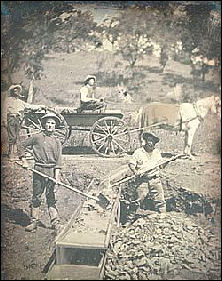Gold Rush Trail Of 49
In 1848 gold was discovered in California and within a year of its discovery, emigrants using the California Trail were flooding into the Sierra Nevada Range by the thousands.
It all started when John Sutter who was a Swiss immigrant came to California in 1839 with a dream of building an agricultural empire. When he needed lumber in early 1848, he assigned the task to one of his men, James Marshall. Marshall decided to build a sawmill on the South Fork of the American river, about 40 miles from Sutter's home. Marshall discovered a gold nugget on January 24, 1848, while at the sawmill. He and his men found more gold nearby. Both Marshall and Sutter tried to keep things quiet, but soon word leaked out. Gold fever quickly became an epidemic.
Many who already had arrived in California or Oregon immediately gravitated to the western Sierras. But it wasn't until December of 1848 that President James Polk confirmed the findings to Congress, which meant it was too late to start a trip for easterners. But by the spring of 1849, the largest migration (25,000 that year alone) in American history was already taking place. Better-than-average conditions on the plains and in the desert that spring and summer helped soften the blow of the wave of emigrants. But conditions were harsh at best and many livestock were lost along the way. Grass and clean water became scarcer as the trip wore on, and diseases like cholera took their toll.
Indians in particular suffered from the "Forty-Niners" who streamed across the land. For centuries, Indians had lived in the West without outside competition for resources. But now the pioneers' lust for wealth was threatening to decimate the Indians through the consumption of foods, lands, water and space.
Many new routes were opened into California as a result of the Gold Rush. With an estimated 140,000 emigrants arriving in California via the California Trail between 1849 and 1854, routes were continually modified, tested or even abandoned.
The travelers of the California Trail often quipped that if you had "seen the elephant," then you had hit some hard traveling.Early emigrants once called the California Trail an elephant, due to the difficult journey. If you wanted to get to California in pre-railroad times, you were guaranteed an arduous trek. California emigrants faced the greatest challenges of all the pioneer emigrants of the mid-19th century. In addition to the Rockies, these emigrants faced the barren deserts of Nevada and the imposing Sierra Nevada Range. Eventually, the portions of the railroad followed parts of the California Trail and as the automobile was introduced and began to be used by the masses, highways replaced the trail. Today, U.S. Highways 40 and 80 follow the path of the California Trail.
The California Trail system, which now includes approximately 5,665 miles of trails, was developed over a period of years. Numerous cut offs and alternate routes were tried along the California Trail to see which was the "best" in terms of terrain, length and sufficient water and grass for livestock. Today, more than 1,000 miles of trail ruts and traces can still be seen in the vast undeveloped lands between Casper, Wyoming and the West Coast, reminders of the sacrifices, struggles, and triumphs of early American travelers and settlers. About 2,171 miles of this system cross public lands, where most of the physical evidence that still exists today is located, including the names of emigrants written with axle grease on the rocks at the City of Rocks National Reserve in southern Idaho. More than 300 historic sites along the trail will eventually be available for public use and interpretation.

